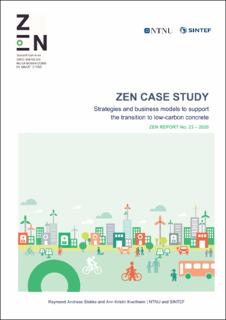| dc.description.abstract | Strategies and business models to support the transition to low-carbon concrete
This report evaluates business models and market measures for transitioning to low-carbon concrete with carbon capture and storage (CCS) in Norway’s largest cement producer, Norcem. The findings of this report are based on a study conducted as part of the Research Centre on Zero Emission Neighbourhoods in Smart Cities (FME ZEN), of which Norcem is a partner. Findings are analyzed and synthesized using a case study methodology, and the most significant drivers and barriers for implementing CCS technologies in the Norwegian cement context are discussed.
Research shows that there is great potential for CCS to influence cost reduction in the long term because of economies of manufacturing scale and enhanced design integration. While high upfront costs are expected, operational cost reduction could be attainable for Norcem, especially given the potential for second- and third-generation capture technologies. One of the main problems that Norcem faces pertains to burden-sharing throughout the value chain, as well as high investment cost. Additionally, compared to renewable technologies, CCS is not suitable for fragmented installation; to be successful, it must be deployed full-scale throughout any given industrial site.
Presently, the Norwegian government subsidizes different renewable energy technologies domestically; however, with climate reduction technologies such as CCS, there is an inevitable prerequisite for high initial financial investment. Another prerequisite is a definite income stream based around a steady— and adequately high—carbon price in the near future. Assuming that carbon emissions are perpetually increasing, including in the cement industry, the argument for CCS is strong. Our findings show that storage, safety, and technical matters can be solved; however, the large initial investment costs persist. Burden-sharing between producer and end user is, therefore, a dilemma. To overcome this dilemma, ambitious environmental policies on emissions, coupled with market-driven solutions, are necessary. In creating a pathway for low-carbon cement in the Norwegian market, we recommend the following key measures for government and industry:
1) Invest in and implement full-scale CCS at Norcem’s Brevik plant as a catalyst for the wider market.
2) Enact stable, predictable, and long-term tax deductions for captured CO₂ per ton.
3) Explore a ‘grey’ certificate market as a carbon cost integration mechanism.
4) Focus on accelerating green public procurement and innovation partnerships.
All these measures should be adopted in an interdependent manner. Our findings indicate that key barriers to low-carbon cement are both financial and market related. Early pilot and demonstration projects show that CCS is a viable solution in the Norwegian cement context. Nevertheless, for these to be enacted more broadly, barriers pertaining to cost and pricing throughout the value chain would need to be addressed more effectively. Pertinent policies should act as promoters for the cement industry to continue advancing the most promising green products and technologies. Moreover, the decision to finance CCS technologies poses not only a financial or political query, but also an environmental and social responsibility one. For a company such as Norcem, it is additionally imperative to identify a feasible approach to burden-sharing, coupled with realistic, market-driven solutions. | |
